NCSM Essential Actions Series
- Overview
- Framework for Leadership
- Instructional Leadership
- Culturally Relevant Leadership
- Coaching
- Purchase
Overview of Leadership Resources
In the face of an ever-changing national and global landscape, it has rarely been more necessary to employ bold leadership in order to ensure that our students have equitable access to deep and meaningful mathematics. To that end, mathematics leaders secure and develop resources that support a vision for exceptional mathematics teaching and learning for each and every student. Over the past two decades, we have seen the emergence of a significant number of resources that claim our vision. Research-affirmed strategies, many enhanced and made more accessible by technology, have become visible to teachers, coaches, and leaders.
In an effort to help mathematics leaders make sense of the available research and associated resources, NCSM has developed the following resources (and will continue to develop additional resources supporting mathematics education leadership) designed as “best practice” guides for mathematics leadership, teaching, and learning:
- Framework for Leadership in Mathematics Education
- Instructional Leadership in Mathematics Education
- Culturally Relevant Leadership in Mathematics Education
- Coaching in Mathematics Education
These resources are grounded in four guiding principles and four foundational elements of mathematics leadership.
A guiding principle is a belief or ideal that defines the work of an organization and transcends changes in circumstance, leadership, or any of the other working parts of that organization. Through that lens, the four guiding principles identified in the NCSM Essential Actions: Framework for Leadership in Mathematics Education include clarity and focus for how to lead PreK-12 mathematics. The combination of the foundational elements and the guiding principles provides structure for defining the role of any individual who leads mathematics instructional programs in a school, district, state/province or institute of higher education.
NCSM Essential Actions: Framework for Leadership in Mathematics Education
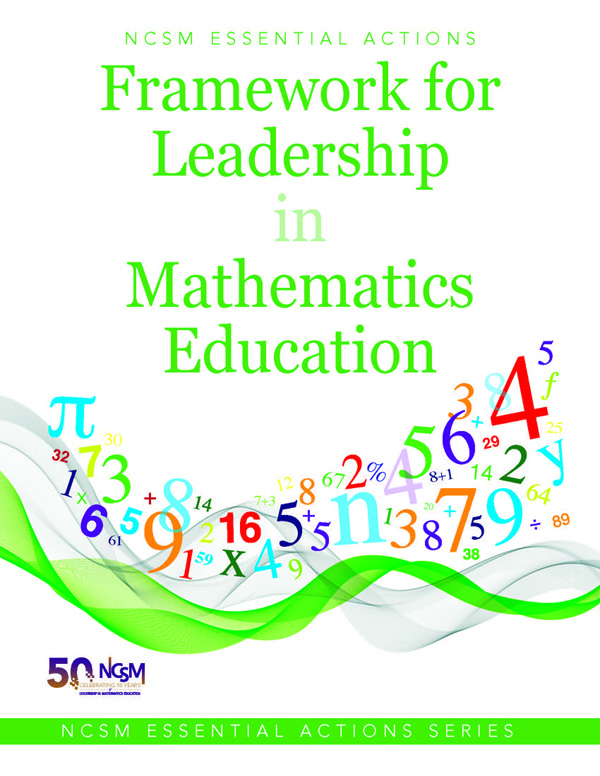
The Framework for Leadership in Mathematics Education, is the third book in the NCSM Essential Actions Series. Building on our previous work with The PRIME Leadership Framework: PRinciples and Indicators for Mathematics Education (NCSM, 2008) and It’s TIME: Themes and Imperatives for Mathematics Education (NCSM, 2014), our new Essential Actions for bold mathematics education leadership focus around four guiding principles and four foundational elements of mathematics leadership.
Ultimately, the success of a mathematics education leader resides in the influence the leader leaves on the next generation of mathematics education teachers, leaders, programs, and impact on student learning. Leaders that make a difference take a stand and commit themselves, and those they lead, to a complex yet crystal-clear set of leadership actions. Bold leaders consider their guiding principles and take a stand in ways that support enacting those principles.
The NCSM Framework for Mathematics Leadership identifies key essential actions: twelve imperatives that bold mathematics education leaders use to identify ways in which they can take a stand in support of teachers and students in their organization. Every leader is capable of making commitments for things that matter and giving meaning to values that will significantly impact student learning. This is what it means to live a courageous and bold leadership life.
Free Reproducibles from “NCSM Essential Actions: Framework for Leadership in Mathematics Education”
Chapter 1
- Figure 1.3. Leadership Roles With the Advocate Guiding Principle
- Figure 1.5. Vision Casting Protocol
- Figure 1.7. Curriculum Components Analysis Tool
- Figure 1.8. Leadership Role-Based Curriculum Reflection Questions
- Figure 1.9. Alignment Protocol
- Figure 1.10. Questions and Resources to Support Stakeholders
- Figure 1.11. MTP Continuum
- Figure 1.12. Text-Based Discussion Protocol and story
- Figure 1.13. The Revised CRCD Mathematics Task Framework
- Figure 1.14. Reflection on Culturally Relevant Mathematical Tasks
- Figure 1.16. Reflection Tool for Leadership Actions
- Figure 1.17. Self-Reflection on Guiding Principle 1
Chapter 2
- Figure 2.3. Leadership Roles With the Design Guiding Principle online only
- Figure 2.4. Reflection on Leading Through the Lens of Social Justice
- Figure 2.6. Mathematics Leadership Actions for Detracking
- Figure 2.7. Leadership Actions Supporting Teachers’ Mathematics Curriculum Knowledge
- Figure 2.8. Reflection on Conditions for Meaningful Collaboration
- Figure 2.10. Strategies to Support Engaging Stakeholders
- Figure 2.11. Reflection Questions to Guide Equity Through Professional Learning
- Figure 2.12. Reflection on Leadership Actions
- Figure 2.13. Actions Supporting Collaborative Professional Learning
- Figure 2.15. Professional Learning Aligned to Student Learning
- Figure 2.16. Self-Reflection on Guiding Principle 2
Chapter 3
- Figure 3.3. Leadership Roles With the Empower Guiding Principle (Online only)
- Figure 3.4. Productive Beliefs About Access and Equity in Mathematics Tool
- Figure 3.5. Reflective Questions for Mathematical Identities
- Figure 3.6. Types of Knowledge
- Figure 3.9. Structures Supporting Building Relationships
- Figure 3.15. Self-Reflection on Guiding Principle 3
Chapter 4
- Figure 4.3. Leadership Roles With the Monitor Guiding Principle (online only)
- Figure 4.5. Mathematics Leadership Actions to Monitor Learning From Assessments
- Figure 4.6. Data Analysis Protocol for a Classroom Formative Assessment
- Figure 4.8. Here’s What, So What, Now What Data Analysis Protocol
- Figure 4.9. Team Common Mid-Unit Data Analysis Protocol
- Figure 4.10. Team Common End-of-Unit Data Analysis Protocol
- Figure 4.11. Questions to Monitor Team Intensification Plans
- Figure 4.13. Grade 8 Student Reflection Example
- Figure 4.15. Assessment Leadership Actions
- Figure 4.17. Questions to Monitor Team Intensification Plans
- Figure 4.18. Data Analysis Protocol
- Figure 4.21. Self Reflection on Guiding Principal
Chapter 5
- Figure 5.3. Reflection Tool for Foundational Elements
- Figure 5.4. Plan-Do-Study-Act Cycle of Reflection and Action
Order a copy of NCSM Essential Actions: Framework for Leadership in Mathematics Education today for yourself or colleagues for further discussion and planning.
NCSM Essential Actions: Instructional Leadership in Mathematics Education
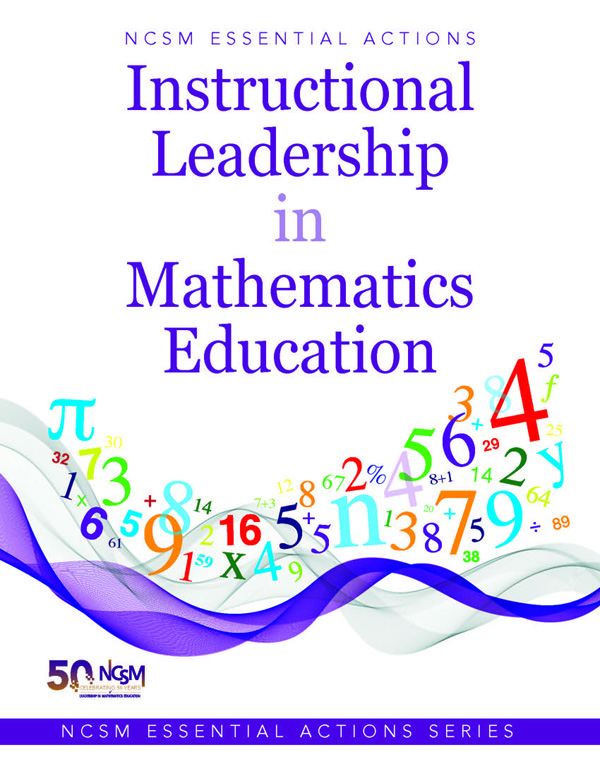
School-based administrators wear many hats as the primary instructional leader to the students, teachers, and community they serve. The latest book from NCSM in the Essential Action Series is a go-to resource for principals as they work toward increasing mathematics learning for each and every learner. This hands-on resource details the essential actions for mathematics leadership and includes:
- Designing effective school improvement processes
- Leading and managing systems of change
- Developing and activating the school’s mission, vision, values, and goals
- Leading through a lens of equity, cultural responsiveness, and social justice
- Creating and sustaining a culture of high expectations for learning
- Building the professional capacity of school staff
- Creating and sustaining effective professional communities of reflective practitioners
With voices from the field and a comprehensive set of resources for leading mathematics, this book provides practical and actionable research-affirmed strategies that will improve mathematics teaching and learning.
Free reproducibles from "NCSM Essential Actions: Instructional Leadership in Mathematics Education"
Chapter 1
- Figure 1.1 School-Based Mathematics Program Needs Assessment Tool
- Figure 1.2 Essential Actions Reflection Tool
Chapter 2
- Figure 2.3 Productive Beliefs About Access and Equity in Mathematics Tool
- Figure 2.4 Mathematics Teaching Practices School Leadership Team Reflection
- Figure 2.9 EA1: Define and Develop a Shared Vision for High-Quality Mathematics Teaching and Learning (Self-Reflection)
Chapter 3
- Figure 3.4 Principal Reflection on Plan, Do, Study, Act Cycle
- Figure 3.6 EA2: Continually Monitor the Implementation of the Vision and Provide Feedback to Teachers in Meeting the Vision (Self-Reflection)
Chapter 4
- Figure 4.3 Instructional Process Reflection
- Figure 4.5 MTP Continuum Tool
- Figure 4.16 EA3: Require Consistent High Expectations for All Students and Teachers (Self-Reflection Tool)
- Figure 4.17 EA4: Provide Opportunities and Resources to Develop Knowledge of Relevant Meaningful Mathematics (Self-Reflection Tool)
Chapter 5
- Figure 5.1 Four Critical Actions for Structures for Teacher Learning
- Figure 5.2 Four Critical Actions for Structures That Support Student Learning
- Figure 5.9 EA5: Develop Structures for Continual Job-Embedded Professional Learning (Self-Reflection)
- Figure 5.10 EA6: Develop Structures and Systems to Support Intensification and Extensions to Meet the Learning Needs of All Students (Self-Reflection)
- Learning Trajectories – Online only
Chapter 6
- Figure 6.3 Data Analysis Protocol
- Figure 6.4 Data Chat Reflection Guide
- Figure 6.8 Team Response for Intensification
- Figure 6.11 EA7: Create Structures to Collectively Collect, Analyze, and Celebrate Evidence of Student Learning (Self-Reflection)
- Instructional Roadmap – Online only
Order a copy of NCSM Essential Actions: Instructional Leadership in Mathematics Education today for yourself or colleagues for further discussion and planning.
Culturally Relevant Leadership in Mathematics
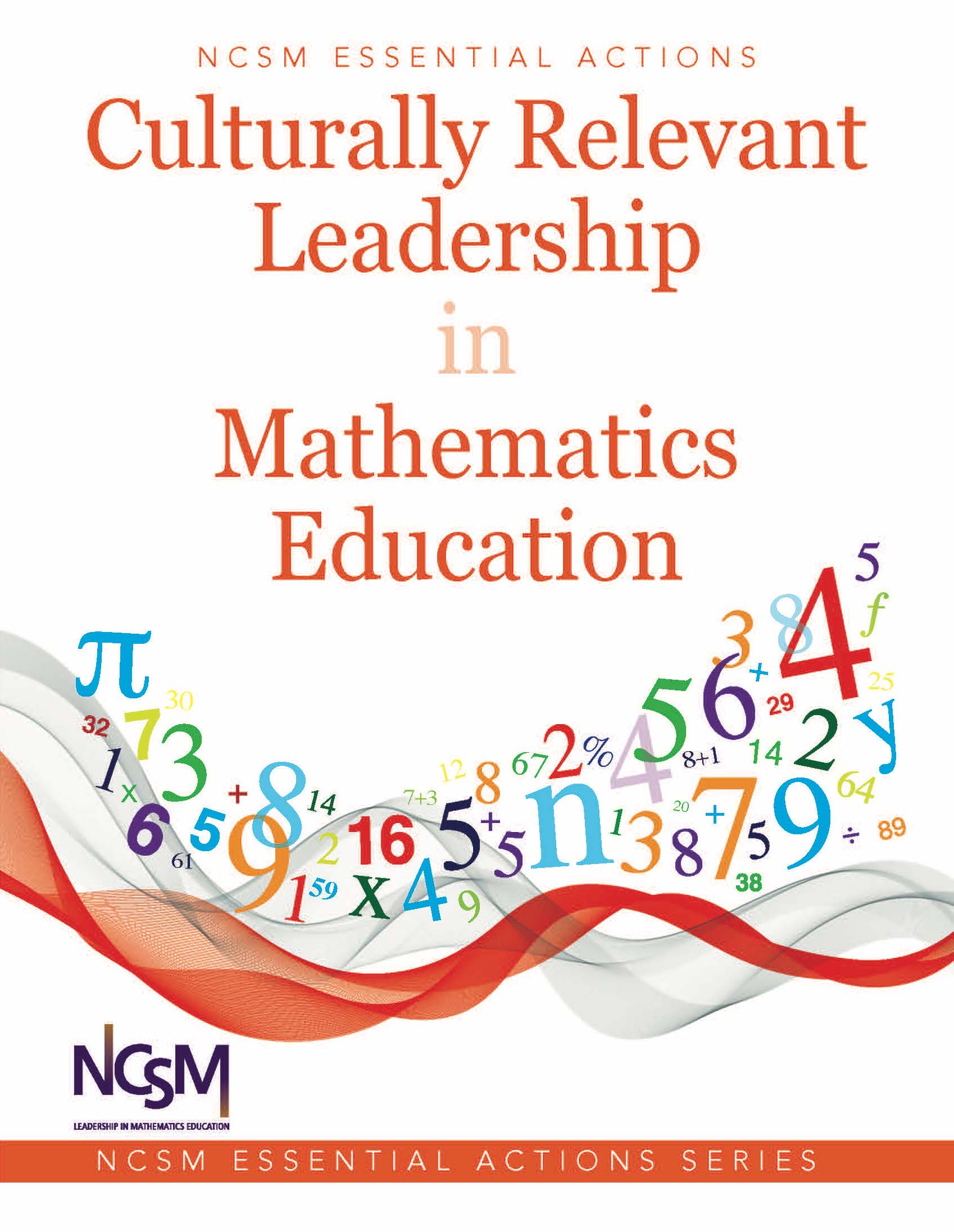
The NCSM vision clarifies the focus on student learning outcomes and directs the charge to “guarantee that all students engage in equitable, high-quality mathematical experiences.” So, how do we as mathematics leaders and members of NCSM bring the vision to life and ensure equitable student engagement in mathematics classrooms of the teachers we serve? How do we ensure that students who have been traditionally marginalized see themselves as mathematicians?
Culturally Relevant Leadership in Mathematics Education focuses on the essential actions leaders must apply to ensure students are engaged in culturally relevant and equitable mathematics instruction. This book provides action steps and resources to support the following guiding principles:
- Empowering students through culturally relevant practices
- Designing culturally relevant tasks
- Monitoring culturally relevant practices
- Advocating for culturally relevant practices
Included in this book are four culturally relevant tasks and a comprehensive set of resources for leading culturally relevant mathematics. This book provides practical and actionable research-affirmed strategies that will improve mathematics teaching and learning.
Free reproducibles from “NCSM Essential Actions: Culturally Relevant Leadership in Mathematics Education”
Introduction
Chapter 1
- Figure 1.8 The Revised CRCD Mathematics Task Framework
- Figure 1.9 Culturally Relevant Leadership Reflection
Chapter 2
- Figure 2.3 Empower Leadership Actions for Guiding Questions
- Figure 2.12 Culturally Relevant Leadership: Stakeholder Voice Reflection
- Figure 2.15 Empower Task Analysis Questions
- Figure 2.17 Our Counting Collections: Grades K-2 Adapted Task
- Figure 2.18 Self Reflection on Empower Guiding Principle
Chapter 3
- Figure 3.6 Design Leadership Actions with Guiding Questions
- Figure 3.7 Professional Learning Needs Survey on Team Understanding
- Figure 3.10 Our Vegetable Garden, Grades 6-8 Adapted Task
- Figure 3.11 Self Reflection on Design Guiding Principle
Chapter 4
- Figure 4.3 Monitor Leadership Actions with Guiding Questions
- Figure 4.5 Cycle of Continuous Improvement Self-Reflection Questions
- Figure 4.15 Who Has More: Grades 3-5 Adapted Task
- Figure 4.16 Self Reflection on Monitor Guiding Principle
Chapter 5
- Figure 5.4 Advocate Leadership Actions with Guiding Questions
- Figure 5.7 Reflection of Mathematics Vision
- Figure 5.8 Structures at the Classroom, School, and System Levels
- Figure 5.9 Reflection on Leadership Actions
- Figure 5.10 Equitable Mathematics Teaching Practices Reflection Tool
- Figure 5.18 Self Reflection on Advocate Guiding Principle
Order a copy of NCSM Essential Actions: Culturally Relevant Leadership in Mathematics Education today for yourself or your colleagues for further discussion and planning.
NCSM Essential Actions: Coaching in Mathematics Education
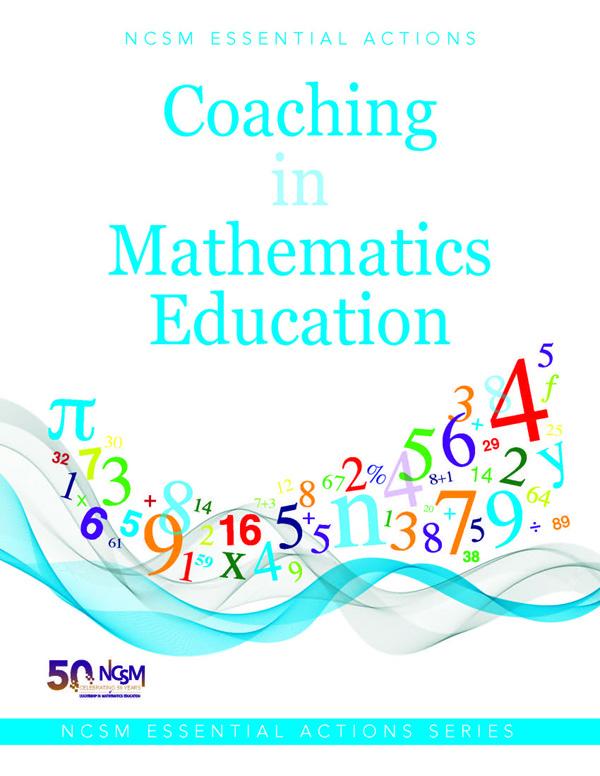
Mathematics coaching has been shown to be one of the most effective ways to increase teacher effectiveness and student learning. The book Coaching in Mathematics Education, from NCSM’s new Essential Action Series, will serve as a guiding reference for coaches, teachers, administrators, and others as mathematics coaching programs become more prevalent throughout schools worldwide.
The book is structured around sets of Foundational Elements and Essential Actions of mathematics coaching programs (i.e., sets of ideas that are vital to implementing a successful mathematics coaching program).
- Chapter 1 provides a model for the organization of this book. The building metaphor became our logic model, with students placed at the apex of our construction. We surround students with teachers, as they are the direct link to student learning. Surrounding the teachers, we placed both principals and coaches, each doing their own part to support teachers’ efforts to improve and grow professionally.
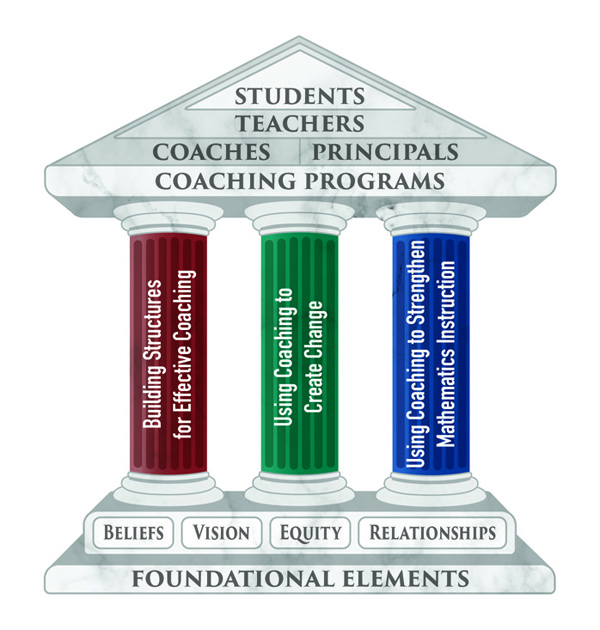 Chapter 2 lays out and describes the four Foundational Elements of coaching – Beliefs, Vision, Equity, and Relationships. These elements, located at the foundation of our building, provide the stability upon which an effective mathematics coaching program is built. These foundational elements permeate all of the Essential Actions in the following chapters.
Chapter 2 lays out and describes the four Foundational Elements of coaching – Beliefs, Vision, Equity, and Relationships. These elements, located at the foundation of our building, provide the stability upon which an effective mathematics coaching program is built. These foundational elements permeate all of the Essential Actions in the following chapters.- Chapters 3 – 5 focus on the Essential Actions contained in each pillar of our Model. The red pillar is devoted to two Essential Actions for sustainable coaching necessary for building structures for effective coaching. The green pillar contains the three Essential Actions for coaching interactions and how to use them effectively to create change. Finally, the blue pillar details three Essential Actions encompassing the range of knowledge, understandings, and skills that become the focus of a coach’s work with teachers to strengthen instruction.
- Epilogue – summarizes and draws connections among the Essential Actions and Foundational Elements.
With detailed explanations and examples, this book provides sensible and actionable research-affirmed methods and structures that will strengthen and improve your mathematics coaching programs and coaching leading to improved student learning.
Free reproducibles from "NCSM Essential Actions: Coaching in Mathematics Education"
Introduction
- Foundational Elements and Essential Actions
- Figure 1.1: Research-informed impact of Coaching Programs
Chapter 2 – Foundational Elements
- Figure 2.3g: NCSM Coaching Beliefs
- Figure 2.4: Coaching Beliefs Associated with Fixed and Growth Mindsets
Chapter 3 – Building Structures for Effective Coaching
Chapter 4 – Using Coaching to Create change
- Figure 4.1: Rules for Assessments and Data Analysis
Chapter 5 – Using Coaching to Strengthen Mathematics Instruction
- Figure 5.1: Potential Focus Areas for Coaching
Appendix B – Coaching Model Decision-Making Tool
Order a copy of NCSM Essential Actions: Coaching in Mathematics Education today for yourself or colleagues for further discussion and planning.
To purchase any of the books below in the Leadership Series, visit the publications page in Memberclicks.
- Essential Actions: Framework for Leadership in Mathematics Education $27
- Essential Actions: Instructional Leadership in Mathematics Education $27
- Essential Actions: Coaching in Mathematics Education $29
- Essential Actions: Culturally Relevant Leadership in Mathematics Education $29
- Monograph 2019: Acknowledging Our Role in the Education Debt $12
- The Prime Leadership Frameworks $19

